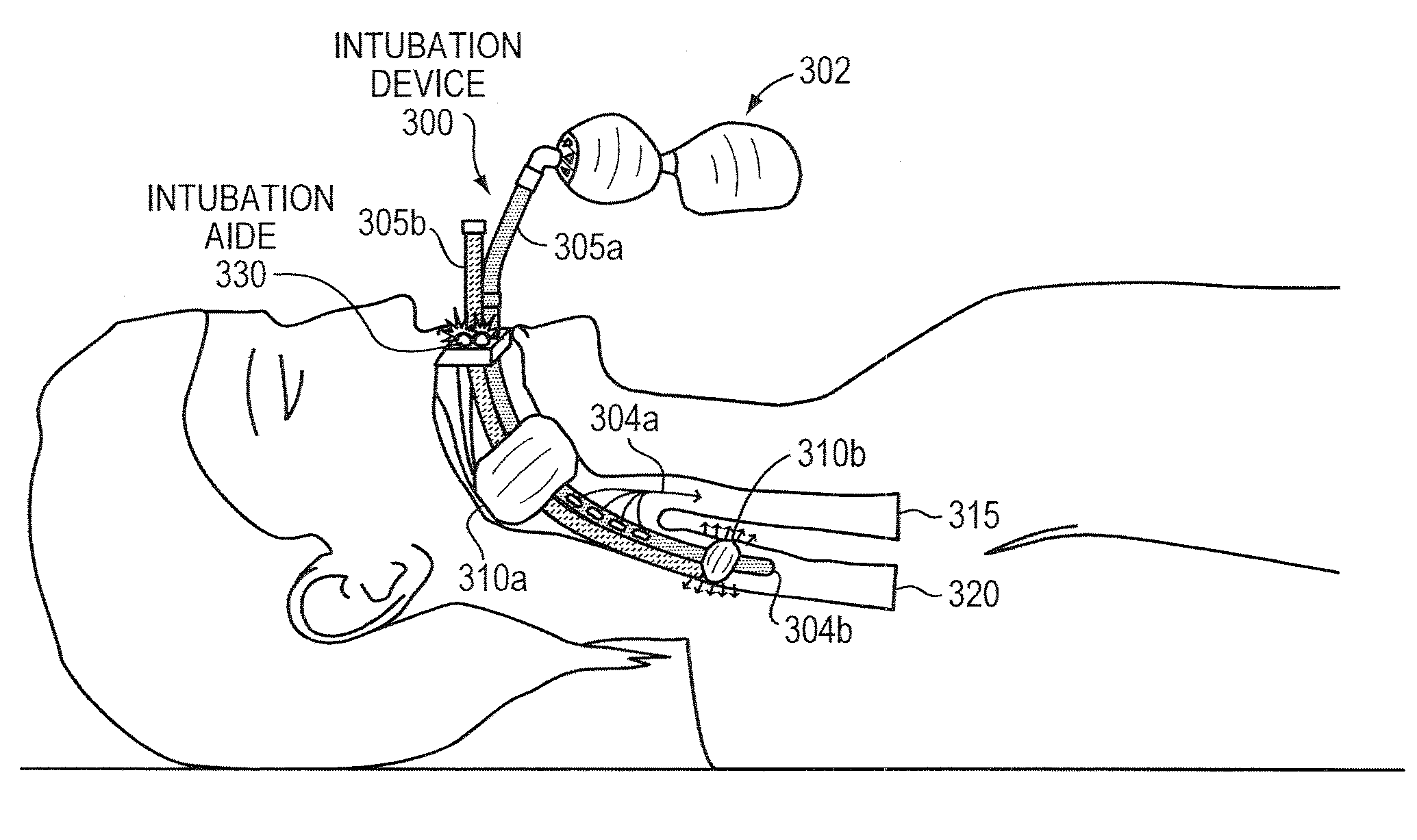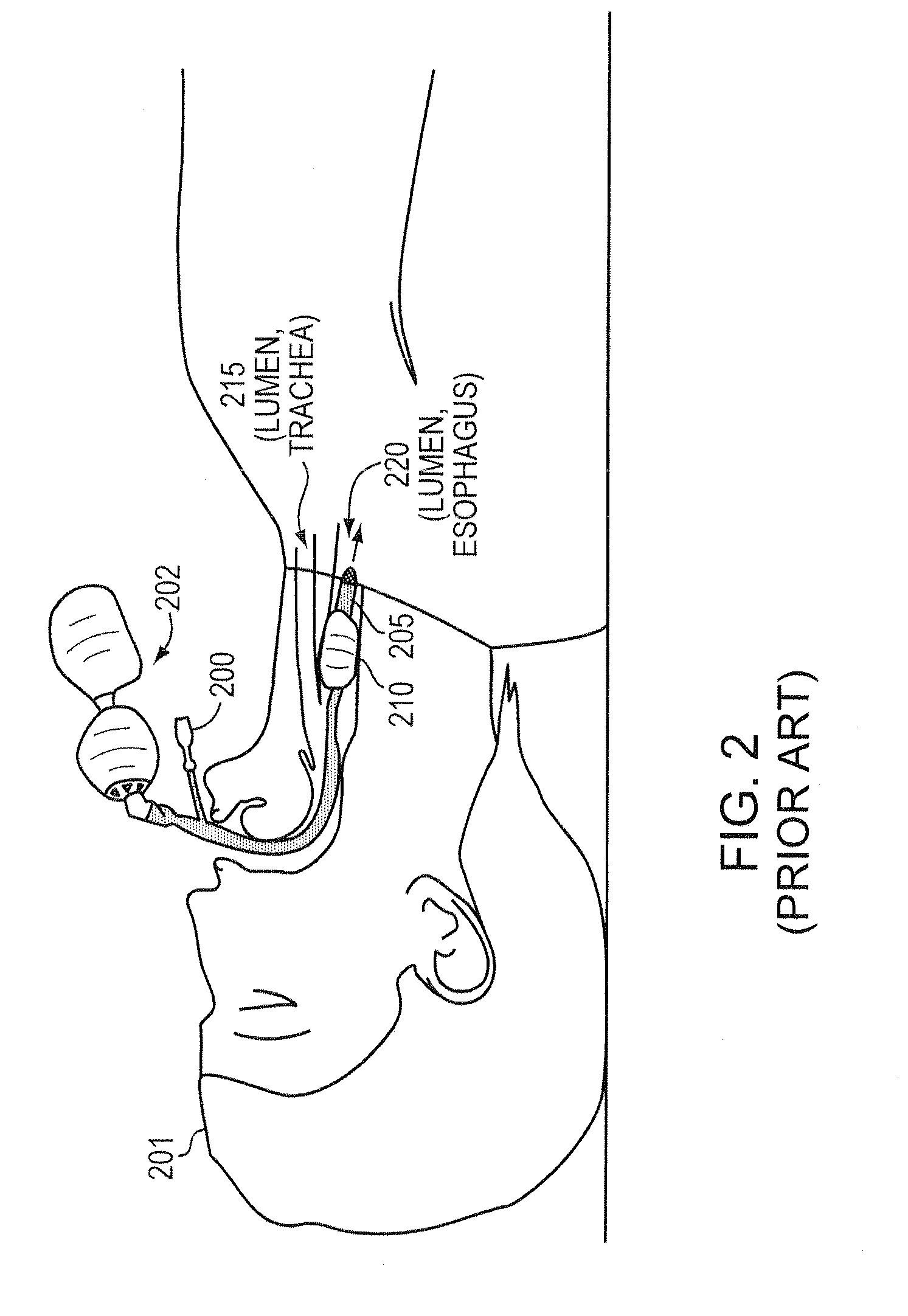Methods and apparatus for safe application of an intubation device
a technology of intubation device and safe application, which is applied in the direction of calibration apparatus, instruments, catheters, etc., can solve the problems of suffocating patients, internal bleeding or death of patients, and inability to accurately maintain the pressure in the cu
- Summary
- Abstract
- Description
- Claims
- Application Information
AI Technical Summary
Benefits of technology
Problems solved by technology
Method used
Image
Examples
example device
Configurations
[0081]Intubation devices according to some embodiments of the present invention comprise at least one sensor such as a pressure sensor or a force sensor, at least one air pump, connectors, tubing, tubing connectors, air release valve(s), circuitry such as logic gates, microcontrollers, op-amps, transistors, resistors, and the like, a user interface, and a power source such as a battery pack, over-charged capacitor, or lithium, alkaline batteries, or the like.
[0082]In some embodiments, the intubation devices of the present invention are portable. In some embodiments, the intubation devices according to the present invention may further comprise operational indicators such as lights, sound speakers, or LCD screen, transmitter to transmit data to an external device, receiver to receive data or commands from an external device, and buttons or switches.
[0083]It should be understood that components and corresponding methods beyond basic intubation tube(s) with associated lum...
experiment 1
[0093]Pump Controller
[0094]Step 1a Pressure Sensor calibration: A MPX5050 Integrated Silicone Pressure Sensors was tested with a manometer to verify that the voltage output correctly followed Voltage Output=Vcc*(0.018*Pressure+ / −0.04).
[0095]Step 1b Force sensor calibration: Tekscan Flexiforce Piezoresistive Force Sensor(s) were calibrated using small weights, measured in increments of 5 grams, and an inverting amplifier, used to verify that it follows Voltage output=−Voltage Input (Fixed Resistance / Flexiforce variable resistance).
[0096]Step 2 Pump Controller Analyzer calibration: The pump controller analyzer, employing a comparator, was tested with an input voltage that matched the expected voltage from the pressure or force sensor(s). The analyzer gave an output voltage changing from +Vcc to 0 volts, once the expected voltage was inputted.
[0097]Step 3 Pressure or Force Sensors and Pump Controller's Analyzer: The pressure or force sensor(s) were tested together along with the pump c...
experiment 2
[0106]In order to determine the use of this technology in human beings, the following experiment was conducted in an animal model. Pigs were utilized, as they have similar respiratory system to other mammalian species.
[0107]Two pigs were utilized in each of the two experiments (Experiment 2A and Experiment 2B). The pigs were initially sedated with Telazol 4.4 mg / kg and Xylazine 2.2 mg / kg, and maintained sedation with 2.00% Isoflurane.
[0108]Experiment 2A—employed each of the designed tubes measuring the forces in the fore and aft sides of the cuff using the Flexiforce piezoresistive force sensors (with the output measured in resistance, but converted to conductance to illustrate force increase) in both the trachea and esophagus. All of the designed tubes were tested by filling their cuffs to their maximal volume; the respective maximum volumes values were as follows: 100 ml and 15 ml for the proximal and distal cuff of the resuscitation tube, 60 ml for the connected cuffs of the tran...
PUM
 Login to View More
Login to View More Abstract
Description
Claims
Application Information
 Login to View More
Login to View More - R&D
- Intellectual Property
- Life Sciences
- Materials
- Tech Scout
- Unparalleled Data Quality
- Higher Quality Content
- 60% Fewer Hallucinations
Browse by: Latest US Patents, China's latest patents, Technical Efficacy Thesaurus, Application Domain, Technology Topic, Popular Technical Reports.
© 2025 PatSnap. All rights reserved.Legal|Privacy policy|Modern Slavery Act Transparency Statement|Sitemap|About US| Contact US: help@patsnap.com



